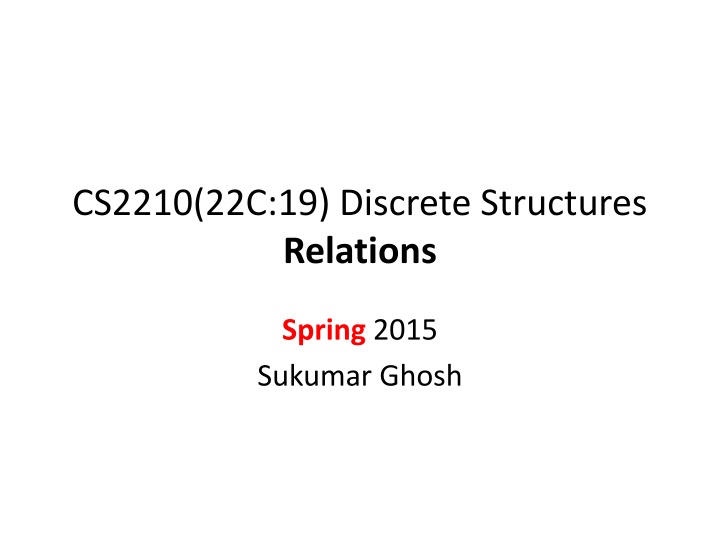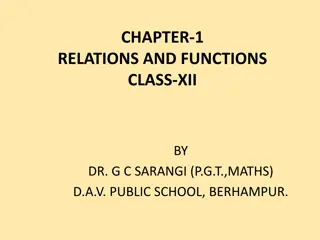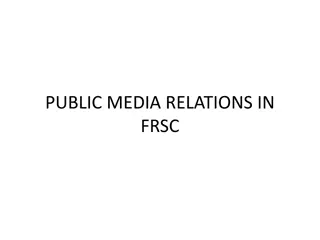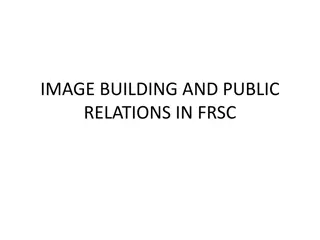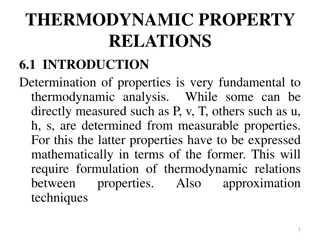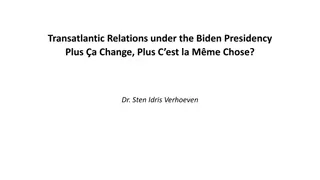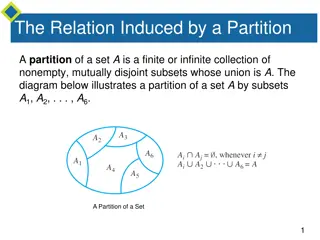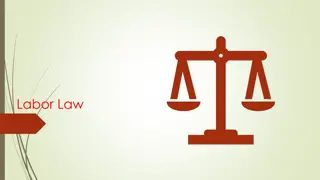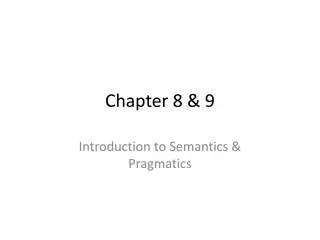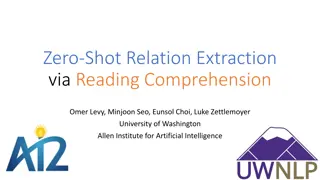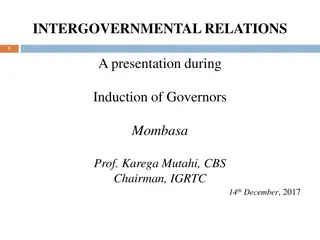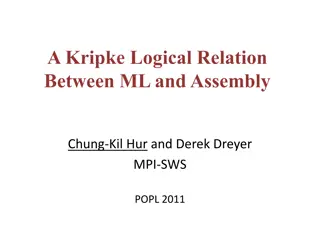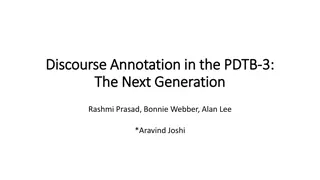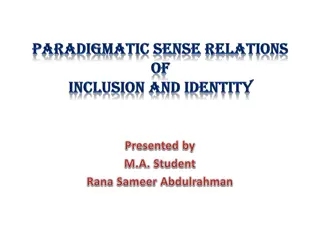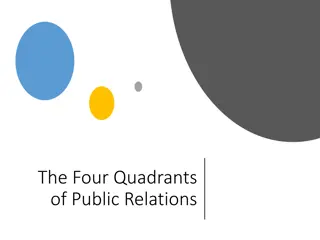Relations
Concept of relations in discrete structures, including examples, representations, and properties such as reflexivity, symmetry, antisymmetry, and transitivity. Learn about when to use relations versus functions and delve into various types of relations, their characteristics, and practical applications.
Download Presentation

Please find below an Image/Link to download the presentation.
The content on the website is provided AS IS for your information and personal use only. It may not be sold, licensed, or shared on other websites without obtaining consent from the author.If you encounter any issues during the download, it is possible that the publisher has removed the file from their server.
You are allowed to download the files provided on this website for personal or commercial use, subject to the condition that they are used lawfully. All files are the property of their respective owners.
The content on the website is provided AS IS for your information and personal use only. It may not be sold, licensed, or shared on other websites without obtaining consent from the author.
E N D
Presentation Transcript
CS2210(22C:19) Discrete Structures Relations Spring 2015 Sukumar Ghosh
What is a relation? Let A, B be two sets. A binary relation R is a subset of A X B. Example. Let A = {Alice, Bob, Claire, Dan) be a set students, and B= {CS101, CS201, CS202) be a set of courses. Then, a possible relation is: {(Alice, CS101), (Bob, CS201), (Bob, CS202), (Dan, CS201), (Dan, CS202)} If |A|= m and |B|= n, then there can be as many 2mn distinct relations (why?).
When to use which? A function yields a single result for any element in its domain. Example: age (of a person), square (of an integer) etc. A relation allows multiple mappings between the domain and the co-domain. Example: students enrolled in multiple courses.
Properties of Relations We study six properties of relations: What are these?
Reflexivity Example. = is reflexive, since a = a is reflexive, since a a < is not reflexive is a < a is false.
Summary of properties = < > Reflexive X X X Irreflexive X X Symmetric X Asymmetric X X Antisymmetric X X X Transitive X X X X X
Operations on relations Let A = {1, 2, 3} and B = (1, 2, 3, 4}. Define two relations R1 = {(1,1), (1,2), (1,3)} R2 = {(1,1), (1,3), (1,4)} Then, R1 R2 = {(1,1), (1,2), (1,3), (1,4)} R1 R2 = {(1,1), (1,3)} R1 - R2 = {(1,2)}
More operations on relations: Composition Let S be a relation from the set A to the set B, and R be and R be a relation from the set B to the set C. Then, the composition of S and R, denoted by S R is {(a, c) | a A, b B, c C such that (a, b) S and (b, c) R} EXAMPLE. Let A = {1, 2, 3}, B = { 1, 2, 3, 4}, C = {0, 1, 2} S = {(1,1), (1,4), (2,3), (3, 1), (3, 4)} R = {(1,0), (2,0), (3,1), (3, 2), (4,1) Then S R = {(1,0), (1,1), (2,1), (2,2), (3,0), (3,1)
More operations on relations: Composition Rn = Rn-1 R = R R R R (n times) EXAMPLE. Let R = {(1,1), (2,1), (3,2), (4,3)},. Then R2 = R R = {(1,1), (2,1), (3, 1), (4,2)} R3 = R2 R = {(1,1), (2,1), (3, 1), (4,1)} R4 = R3 R = {(1,1), (2,1), (3, 1), (4,1)} Notice that in this case for all n > 3, Rn = R3
Transitive Closure The transitive closure of a binary relation R on a set S is the transitive relation R* on S such that EXAMPLE. Let S = {1, 2, 3} and R = {(1,1), (2,1), (3,2), (4,3)}. Then R* = {(1,1), (2,1), (3, 1), (3,2), (4,3), (4,2), (4,1)}
n-ary relations Has important applications in computer databases. DEFINITION. Let A1, A2, A3, , An be n sets. An n-ary relation is a subset of A1 x A2 x A3 x x An EXAMPLE. R is a relation on N x N x N consisting of triples (a, b, c) where a < b < c. Thus (1, 2, 3) R but (3, 6, 2) R
Relational Data Model Student Record Name ID Major GPA Alice 211 324 Physics 3.67 Bob 123 456 ECE 3.67 Carol 351 624 ECE 3.75 David 000 888 Computer Science 3.25 The above table can be viewed as a 4-ary relation consisting of the 4-tuples (Alice, 211324, Physics, 3.67) (Bob, 123456, ECE, 3.67) (Carol, 351624, ECE, 3.75) (David, 000888, Computer Science, 3.25)
Relational Data Model Name ID Major GPA Alice 211 324 Physics 3.67 Bob 123 456 ECE 3.67 Carol 351 624 ECE 3.75 David 000 888 Computer Science 3.25 A domain is called a primary key when no two n-tuples in the relation have the same value from this domain. (These are marked red).
Operations on n-ary relations SELECTION Let R be an n-ary relation, and C be a condition that the elements in R must satisfy. Then the selection operator SCmaps the n-ary relation R to the n-ary relations from R that satisfy the condition C. So, from the previous table, one can use a selection operator to filter out the record of all student with GPA > 3.50
Operations on n-ary relations PROJECTION The projection Pi,j,k, ,m maps each n-tuple (a1, a2, a3, , an) to the tuple (ai, aj, ak, , am). Essentially it helps you delete some of the components of each n-tuple. Thus, in the table shown earlier, the projection P1,4 will retain only that part of the table that contains the student names and their GPAs.
Use of the operations on n-ary relations SQL queries SQL queries carry out the operations described earlier: SELECT GPA FROM Student Records WHERE Department = Computer Science
Representing Relations Using Matrices A relation between finite sets can be represented using a 0-1 matrix. Let A = {a1, a2, a3} and B = {b1, b2, b3}. A relation R from A to B can be represented by a matrix MR, where mij = 1 if (ai, bj) R, otherwise mij = 0 b1=1 b2=2 b3=4 a1=1 0 0 0 a2=2 1 0 0 1 1 0 a3=3 The above denotes a relation R from A = {1,2,3} to B = {1,2,4}, where for each element (a, b) of R, a > b
Representing Relations Using Matrices A reflexive relation on a given set A is recognized by a 1 along the diagonal 1 1 0 0 0 1 1 0 1 1 1 1 0 A reflexive relation A symmetric relation How would the matrix of an anti-symmetric relation look like?
Representing Relations Using Digraph A relation on a given set A can also be represented by a directed graph 2 3 1 2 1 1 0 0 1 1 1 0 2 3 1 3 1 1 A directed graph representation of the relation shown on the left Let A = {1, 2, 3}
Equivalence Relations An equivalence relation on a set S is a relation that is reflexive, symmetric and transitive. Examples of equivalence relations are: (1) Congruence relation R = {(a,b) | a = b (mod m)} (2) R = {(a, b) | L(a) = L(b)} in a set of strings of English characters}, L(a) denotes the length of English character string a
Equivalence Class Let R be an equivalence relation on a set A. The set of all elements that are related to an element a of A is called the equivalence class of a. The equivalence class of a with respect to R is denoted by [a]R. Example 1. What is the equivalence class of 0 for the relation congruence mod 4? [0]mod 4 = [ -8, -4, 0, +4, +8, ] Relations partition the elements of a set into equivalence classes Question. What are the sets in the partition of the integers arising from congruence modulo 4?
Partial Orders A relation R on a set S is a partial order if it is reflexive, anti-symmetric and transitive. The set (S, R) is called a partially ordered set, or a poset. Examples are (1) the relation, (2) x divides y on the set of positive integers (3) The relation on the power set of a set S
Hasse Diagram Constructing the Hasse diagram for ({1, 2, 3, 4}, }
More examples The relation on the power set of a set S forms a partially ordered set Source: http://en.wikipedia.org/wiki/Partially_ordered_set
